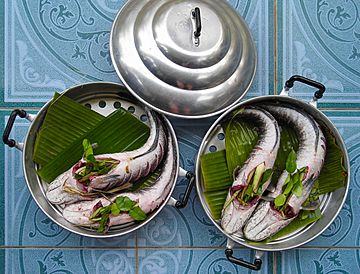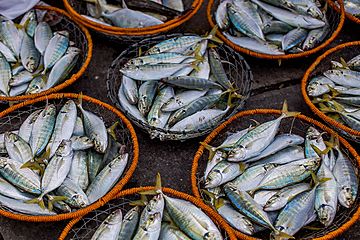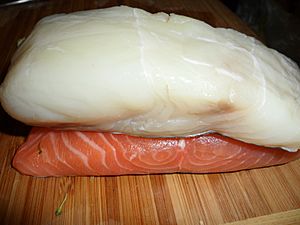Fish as food facts for kids
Fish is a super popular food eaten by people all over the world. For a long time, it has been a key source of healthy protein and other important nutrients. People have been catching and eating fish throughout human history.
Unlike pigs (which become pork), we just call fish "fish" even when it's food! When we talk about "fish" as food, we often include "shellfish". This means creatures like molluscs (clams, oysters), crustaceans (crabs, lobsters), and even echinoderms (sea urchins). All these tasty things from the ocean are called seafood.
Since 1961, people around the world have been eating more and more fish. The amount of fish eaten has grown faster than the world's population growth. In 1961, the average person ate about 9 kilograms (20 pounds) of fish per year. By 2015, this had more than doubled to 20.2 kilograms (44.5 pounds) per person!
This increase happened because we produce more fish. Also, less food is wasted, and it's easier to get fish to people. More people live in cities and have more money to spend, which also increases the demand for fish.
In 1961, Europe, Japan, and the United States ate almost half of the world's fish. But by 2015, Asia ate more than two-thirds of all fish consumed globally. This change shows how Asian countries have become very important in fish production and consumption.
Types of Fish We Eat
Over 32,000 different species of fish have been discovered. This makes them the largest group of animals with backbones. There are also many kinds of shellfish. However, people commonly eat only a small number of these species.
Some common types of fish and shellfish are listed below. They are grouped by how strong their flavor is and how firm their meat feels.
How Fish is Prepared
Fish can be cooked and prepared in many different ways. You can eat it uncooked, like in sashimi. It can also be cured to preserve it and add flavor. This includes marinating (like in ceviche), pickling (like pickled herring), or smoking (like smoked salmon).
Fish can also be cooked in many ways. Popular methods include baking, frying (think fish and chips!), grilling, poaching, or steaming. Many old ways of preserving fish are still used today. This is because they give fish a special taste and texture that people enjoy.
Did you know that a Roman Emperor named Domitian once called a special meeting of the Roman Senate? He wanted them to discuss the best way to cook a turbot fish! This shows how important fish has been throughout history.
Nutritional Benefits of Fish
Fish and fish products provide important nutrients for people around the world. They are a great source of high-quality protein that is easy for your body to digest. Eating fish can also help prevent problems caused by not getting enough important vitamins and minerals.
| Nutrients in 100 grams of Whitefish or Oily Fish | |||
|---|---|---|---|
| Nutrient | Whitefish Alaska pollock |
Oily fish Atlantic herring |
|
| Energy (calories) | 111 | 203 | |
| Protein (grams) | 23 | 23 | |
| Fat (grams) | 1 | 12 | |
| Cholesterol (mg) | 86 | 77 | |
| Vitamin B-12 (µg) | 4 | 13 | |
| Phosphorus (mg) | 267 | 303 | |
| Selenium (µg) | 44 | 47 | |
| Omega-3 (mg) | 509 | 2014 | |
Just a small serving of 150 grams (about 5 ounces) of fish can give you 50 to 60 percent of the protein you need each day! This is especially important in countries where people might not get enough protein from other foods.
Fish is often divided into two main types: whitefish and oily fish.
- Whitefish, like haddock, have very little fat (usually less than 1%).
- Oily fish, such as sardines and salmon, have more fat (between 10–25%).
Oily fish are packed with healthy fats called Omega-3 fatty acids. They also contain important fat-soluble vitamins like A, D, E, and K. All these nutrients are super important for a healthy body!
See also
 In Spanish: Pescado para niños
In Spanish: Pescado para niños




